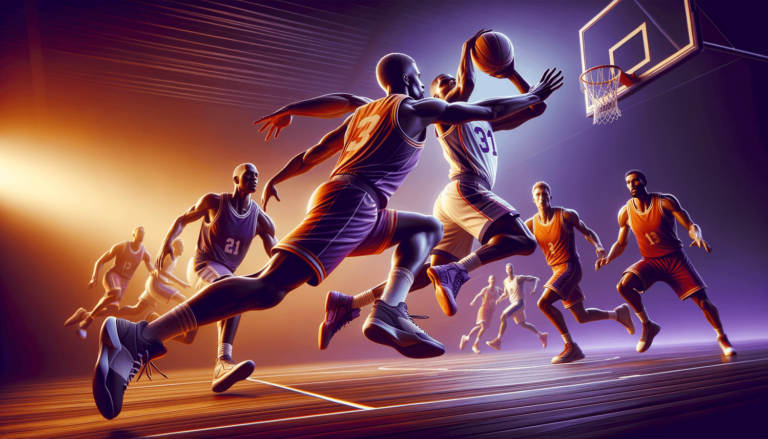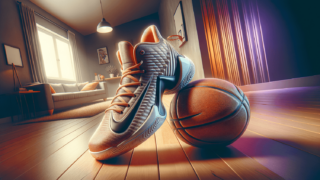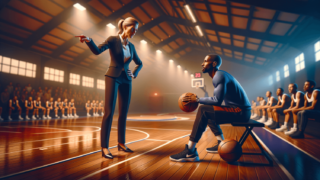
Welcome to the dynamic world of basketball, where a single move can change the trajectory of the game! One of those key moves is the ‘Fake and Drive’, a strategic combination of a head fake and a powerful drive towards the basket. As your guide, I’ll take you on an exciting journey, breaking down the mechanics of this deceptive play, and revealing how it can elevate your game to new heights. Whether you’re a rookie or a seasoned vet, understanding the nuances of the Fake and Drive can be truly transformative, on and off the court. So, lace up your kicks, and let’s dive right in!
What’s a Fake and Drive in Basketball?
A Fake and Drive in basketball is a deceptive move that involves faking a shot or pass to manipulate the defender’s position, followed by a quick drive towards the basket to create scoring opportunities. This technique relies on finesse, footwork, and timing to catch the defender off guard and open up lanes for points or assists.
The Art of the Fake: Deception on the Court
Mastering the Fake and Drive in basketball is an essential skill for anyone looking to elevate their game. This deceptive move can catch defenders off guard and open up scoring opportunities for your team. The key to a successful Fake and Drive lies in a combination of mental sharpness, technique, and practice. Let’s now unravel the various elements of this smart play, starting with the art of deception on the court.
Decoding the Fake
The ‘fake’ part of the Fake and Drive is what sets the stage for the entire move. It involves pretending to execute a shot, pass, or even another move, while actually planning to drive towards the basket. The primary objective here is to create a moment of hesitation, misdirection, or imbalance in the defender’s stance, allowing the player executing the move to exploit this vulnerability to their advantage.
Mastering Multiple Fakes
When it comes to perfecting the fake, variety is the spice of life. There are different types of fakes that players can use to deceive their defenders, such as:
- Shot fake: A shot fake, also known as a pump fake, involves mimicking the motion and body language of shooting the basketball. This can prompt defenders to jump or extend their arms, expecting a shot, allowing the player to drive past them.
- Pass fake: A pass fake is an attempt to make defenders believe that you are passing the ball. This can be done by moving the ball and the eyes in the direction of the intended fake pass. A well-executed pass fake can manipulate defenders to shift out of position, creating new scoring opportunities.
- Jab step: The jab step consists of a quick step towards a particular direction with the non-pivot foot, feigning movement in that direction. When done well, it can get defenders leaning the wrong way, making it easier to drive past them.
The Power of the Drive: Penetrating the Defense
Once you’ve executed a convincing fake, it’s time to capitalize on the opening you’ve created by driving towards the hoops. Remember, the goal is to use the space and time created by the fake to either score or create opportunities for your teammates.
Explosiveness and Agility
A successful drive requires explosive movement and agility. Building up your first step from a fake can be key to beating your defender. Basketball players need to practice their quickness and acceleration to make fast breaks and sharp changes of direction, ensuring they maintain control over the ball.
Footwork and Balance
Proper footwork is essential for executing a smooth drive. Once you’ve completed your fake, it’s crucial to maintain balance when changing direction towards the basket. Stay low and maintain a wide base to avoid traveling violations and to protect the ball from defenders.
Protecting the Ball
Good defensive players will attempt to steal the ball as you start driving. It’s essential to keep the ball low and protected from defenders, especially during the initial drive. Use your body and arms to shield the ball as you penetrate the defense, ensuring you maintain possession.
Drills and Techniques to Elevate Your Fake and Drive
Like any other aspect of the game, mastering the Fake and Drive requires consistent practice and dedication. Here, we’ll provide some practical drills and techniques to help you sharpen this skill and make the most out of it.
Mirror Drills
This partner drill involves one player faking and driving while the other mirrors their movements. It’s an excellent way to work on your deception, as the mirror player’s reaction will give you immediate feedback on the effectiveness of your fakes.
Three Direction Fake and Drive Drill
Develop the ability to execute a fake and drive in multiple directions with this drill. Start on the wings or the top of the key and practice faking a shot, followed by driving to the right, left, or straight towards the basket. Rotate between directions to improve your versatility.
Creating Scoring Opportunities: The Kick-Out Pass
As you perfect your Fake and Drive, you may also want to work on turning this move into a playmaking opportunity. When defenders collapse around you, a smart kick-out pass to an open teammate can result in high-percentage scoring chances and unexpected assists.
Owning the Mental Game
While physicality and practice are essential, your mental approach to the Fake and Drive is equally important. Developing the right mentality can significantly improve the efficiency of your fake and drive.
Mindful Deception
An effective fake demands total conviction from the player. Basketball players should be fully focused on selling the fake with their body language, facial expressions, and gaze, attempting to make it as convincing as possible.
Reading Defenders
In order to exploit vulnerabilities in the defense, it is vital to develop an understanding of your opponents’ tendencies. Reading defenders’ positioning, footwork, and reactions to your fakes will enable you to anticipate their movements and make decisions accordingly.
Embracing the Unknown
With the Fake and Drive, you can never be entirely sure how your defender will react, as they may sometimes play smarter or more aggressively than you anticipated. What’s important is to remain adaptable, adjusting on-the-fly to any unexpected changes.
Learn from the Greats
Lastly, watching and analyzing how professional basketball players execute the Fake and Drive can be an incredibly valuable learning tool. Observe the fakes, footwork, and decision-making processes of elite athletes to get a sense of their techniques and how they can benefit your own gameplay.
By focusing on these crucial aspects of the Fake and Drive move in basketball and incorporating them into your regular practice, you can drastically improve your effectiveness in creating scoring opportunities and contributing to your team’s success on the court.
Defensive Countermeasures: Stopping the Fake and Drive
While the primary focus of our article has been on mastering the Fake and Drive for offensive players, it is also equally important for defensive players to recognize this move and develop countermeasures. Here, we’ll look at some tactics to help defenders stay one step ahead of the Fake and Drive execution.
Watch the Hips, Not the Ball
Offensive players use deceptive moves with their eyes, arms, and the ball to sell their fakes. A good defender should stay focused on the hips of the offensive player, as the hips are more telling of the actual direction the player is likely to move in. Since the ball handler’s hips will always follow the direction of their movement, staying locked in on this area can help defenders make better predictions and minimize their own mistakes.
Stay Grounded
Good defensive players don’t fall for shot fakes easily. Remain grounded and avoid jumping in response to a shot fake. Instead, keep your legs slightly bent and ready to change directions quickly. This will help you better react to potential drives and maintain solid positioning to contest shots.
Keep a Safe Distance
Maintaining the appropriate distance from your opponent will allow you to react more efficiently to shot fakes and drives. Knowing your opponent’s strengths and weaknesses can help you gauge how much space to give them without making it too easy for them to drive or shoot.
Beating the Player to the Spot
Once you read the offensive player’s intentions, attempt to beat them to the spot they are driving towards. This can effectively disrupt the drive and discourage them from penetrating the defense. Remember that quick lateral movement, upper body strength, and anticipation are critical components of successful defense.
Catching Defenders Off Balance: The Euro Step
Another related move that works great in combination with the Fake and Drive is the Euro Step. It’s a maneuver that involves taking two steps in different directions to evade a defender, often causing them to lose balance or commit a blocking foul.
Executing the Euro Step
To perform the Euro Step:
- Approach the defender, typically with speed;
- Take your first step to one side, forcing the defender to commit to that direction;
- Immediately take your second step in the opposite direction, bypassing the defender and creating a clear path to the basket.
When timed correctly, the Euro Step can be an incredibly effective way to wrong-foot defensive players and create scoring opportunities, especially when they are expecting another Fake and Drive.
Enhancing Performance with Strength and Conditioning
Implementing the Fake and Drive, Euro Step, and the defensive tactics mentioned earlier, all require a certain level of physicality. Adding strength and conditioning training to your basketball workout routine can immensely improve your on-court performance.
Key Exercises for Basketball Players
Some fundamental exercises to help develop strength, explosiveness, and agility include:
- Box Jumps: This exercise increases lower body power, which is crucial for driving past defenders and executing explosive moves, such as fakes and jumps.
- Squats: Squats help improve core and lower body strength, improving overall power and stability on the court.
- Agility Ladder Drills: Incorporating agility ladder drills into your training can greatly enhance quickness, footwork, and coordination.
By incorporating these essential defensive countermeasures, the powerful Euro Step, and supplementary strength and conditioning practices, basketball players can significantly enhance their overall performance on the court while keeping their game versatile, unpredictable, and challenging for the opposition.
Frequently Asked Questions (FAQ)
Here are some frequently asked questions and answers related to the Fake and Drive in basketball. These insightful questions and concise answers will aid your understanding and help you excel in the game, whether you’re a player, a coach, or a true basketball enthusiast.
1. Why is the Fake and Drive such an effective move in basketball?
The Fake and Drive is effective because it combines elements of deception and aggression, catching defenders off-guard and creating space for scoring opportunities. When executed well, it can force mismatches, draw fouls, and create open shots for teammates.
2. Can shorter or less athletic players perform the Fake and Drive?
Absolutely! Even though athleticism plays a role in executing the Fake and Drive, deception, footwork, and timing are more essential. Players of all sizes and abilities can master this move by focusing on technique, body language, and maintaining control of the basketball.
3. Can the Fake and Drive be used across all levels of basketball?
Yes, the Fake and Drive is a fundamental basketball move that can be employed at any level of the game, from youth to professional. The key is to practice and adapt the move to suit your individual skill set and the competition you face.
4. What are some other deceptive moves in basketball?
In addition to the Fake and Drive, there are various deceptive moves in basketball, such as the Euro Step, Spin Move, Crossover, and Behind-the-back Dribble. Each move can create scoring opportunities by manipulating defenders and taking advantage of their vulnerable positions.
5. What are some common mistakes when executing the Fake and Drive?
Common mistakes include over-committing to the fake, poor footwork, not protecting the basketball during the drive, and telegraphing the intention to fake. Addressing these issues through practice and awareness can significantly improve the move’s effectiveness.
6. How can I train myself to be more deceptive on the court?
Practice different types of fakes, work on changing speeds, and remain unpredictable in your movements. Study film of great players and incorporate elements of their deceptiveness into your own game. Additionally, focus on being mentally present and committed to selling the fake during gameplay.
7. How can I become better at reading defenders when executing a Fake and Drive?
Developing court awareness, defensive recognition skills, and studying opponent tendencies are crucial to reading defenders. Focus on noticing small cues like foot positioning, body language, and prior reactions to your fakes during the game.
8. Are there any exercises that can help improve my Fake and Drive?
Learning from film sessions, practicing mirror drills, three direction fake and drive drills, and developing strength and agility through exercises, such as squats or box jumps, can directly improve your Fake and Drive.
9. Why is balance important when executing the Fake and Drive?
Balance is essential for maintaining control of the ball, ensuring a smooth drive, and avoiding traveling violations. It also provides stability while transitioning from the fake to the drive, helping the player avoid stumbles or missteps that could disrupt the play.
10. Can the Fake and Drive be effectively used against taller defenders?
A well-executed Fake and Drive can be highly effective against taller defenders, who may have a slower response time due to their size. Using deception to create openings and outmaneuver such defenders can lead to scoring opportunities even against height mismatches.
Featured Posts
- No pillar pages found.





